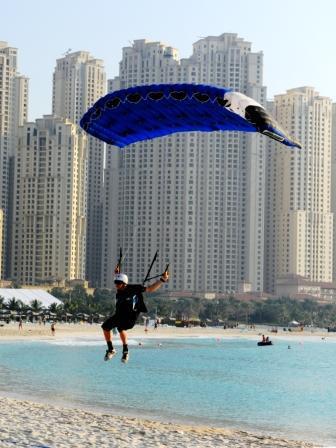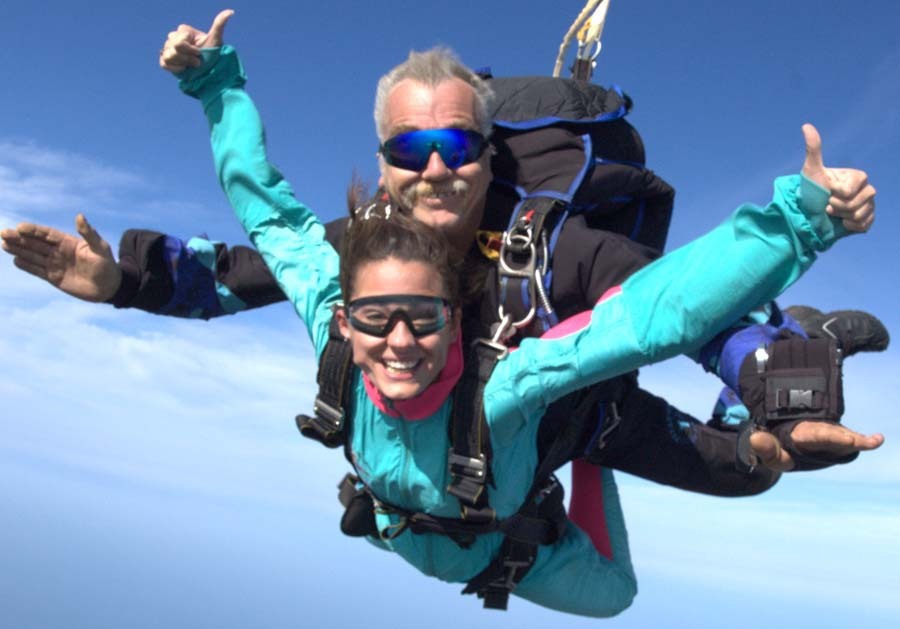Recommended Posts
rhys 0
QuoteOlder Strong, Vector, etc. harnesses are more likely to cause vomiting, but if you apply modern adjustment methods (see Sigma manual or the latest Strong Tandem Newsletter), the incidence of vomiting is low.
The newer adjustment methods seem to work well with all vintages of student harnesses. The key is getting MLWs parellel, so that students are suspended from the front, this eases pressure on femoral arteries. Loosening the belly band further reduces pressure on their stomachs.
Even so, with the lack of closed cell foam in stron harnesses, the comfort level is much lwer and the incidence of vommiting is much more.
io have seen very poor technique used on both systems, the sigma harness is much more forgivable.
The foam used in stron harnesses will turn to 'dust' within a season or two.
can't imaging it saves them much money using a lesser quality foam.
The term 'Its already perfect' springs to mind.
"When the power of love overcomes the love of power, then the world will see peace." - 'Jimi' Hendrix
Thank You Rob,
I do not Know the recommendations of the other manufacturers, but as a Strong Instructor we were taught to leave them connected. The pitfalls of not doing so were clearly explained to us. Regardless of who designed and built the system the same outcome could lead to another sensless fatality. Manufacturers collect and evaluate incident reports, and solicit information from instructors for very good reason. They establish proceedures based on their reports and information from instructors.
I am not the "Rule Boy" etc. that I have been named here - but I do and always will follow proceedures to the best of my ability, regardless of personal experience. I just hope some of what I said here, will prevent an instructor from making a bad choice. If someone really feels that their equipment manufacturer is making a bad recommendation, I suggest they contact them with their concerns.
I do not Know the recommendations of the other manufacturers, but as a Strong Instructor we were taught to leave them connected. The pitfalls of not doing so were clearly explained to us. Regardless of who designed and built the system the same outcome could lead to another sensless fatality. Manufacturers collect and evaluate incident reports, and solicit information from instructors for very good reason. They establish proceedures based on their reports and information from instructors.
I am not the "Rule Boy" etc. that I have been named here - but I do and always will follow proceedures to the best of my ability, regardless of personal experience. I just hope some of what I said here, will prevent an instructor from making a bad choice. If someone really feels that their equipment manufacturer is making a bad recommendation, I suggest they contact them with their concerns.
Youv'e got 54 lbs. of gear on your back - 160 lbs. of stupid on the front - 5 handles all in the wrong place - And a pilot chute in tow - What could possibly go wrong?
riggerrob 644
Agreed "Rule Boy" !
But young skydivers do not always understand the hundreds of thousands of jumps and close calls and fatalities that go in to writing rules.
Sometimes - in these forums - we give them just enough new information to be dangerous.
Hah!
Hah!
But young skydivers do not always understand the hundreds of thousands of jumps and close calls and fatalities that go in to writing rules.
Sometimes - in these forums - we give them just enough new information to be dangerous.
Hah!
Hah!
TVPB 0
general response to thread - not riggerrob
Yes, there is always history and prior experience in rules and the reasoning is often not documented or not easily accessable to the young ones.
Reasons for rules include:
- genuine improvements in safety. These are determined by various means including data collection and analysis, experiemental research, collective brain storming, systematic processes and systems, etc.
- reaction to one off incidents caused by extremely poor decision making by a minority or individual. How do we stop that from happening again?
- response to legal or organisational or political concern - have to be seen to be doing something. Implementation may be rushed or controlled by inappropriate persons. (classic example is aviation industry communication procedures and controlled traffic zones).
Are all rules the most appropriate for your circumstances and situation?
Are all the people making the rules the most appropriate in terms of skills, qualifications, and experience to amke them?
Should you follow every rule in the proverbial book to the letter of the law?
Why should you follow them? Legal, employment security, safety, ethics/values, etc?
i.e. tandem CRW. I think it should not be allowed, but lets put the rule into perspective. Were the incidents that led to the rule caused by ?????????? persons who should not have been performing solo CRW, let alone tandem CRW? Coud it be restricted to people who have achieved a certain level of CRW skills only and not for the rest? For the manufacturer, it is just not worth it. There is no benefit. So they say NNNNOOOOOO.
Lets look at skydiving. People die. They will continue to die. Take the perspective from general society. Skydiving is dangerous and people die. Hence, society recommends to stop it totally. That way no one will die skydiving!!!! Problem solved.
But hang on. It only happens to ?????? % and there are systems in place, and . . . . . .
Lets look at tandems.
Strongs are more prone to having heaps of shit hanging out that could get caught. Let ban it.
Or maybe ensure people are more careful in packing, maintaining gear, moving around aircraft, etc. If people use the gear correctly, it is OK.
Other issues from this thread:
- caught toggles. There are other potential catch points on your rig if you really think about it. Buckles on both harnesses, handles on the tandem harness, helmets, the container, etc. Maybe carry a hook knife. Our DZ does. Or more importantly, when unclipping the side adjusters, clip them closed again.
- the all of a sudden the canopy fails after opening and after canopy checks and after disconnecting the side adjusters scenario (one in a ?????). 99.99 times out of a hundred a canopy failure will happen during the opening sequence. That is when most force is applied. If a cell starts to rip after opening, it will usually do so on weak points which are usually discernable on the ground. This may be a problem if your packer has no idea or you are jumping someone elses gear. Solution: talk to passenger and go through body position routine again. Be prepared for the exo-skeleton method - wrap your legs around their to control the body position.
- the canopy fails after a wild control input. That one is easy to fix. If you can't feel or don't know when you are about to exceed the extremities of you canopies operation (i.e. about to induce line twists, etc) after it is fully deployed and deemed fully functional by you, then ??????????
- canopy fails due to turbulence and you need to cutaway?? See canopy failure above.
Other issues:
- lets look at the handles, The passenger CAN reach them if they really try. Pop goes the reserve into the main!
- they can grab your hands. No control and no deployment.
- they can bring their heads back forcefully on opening and knock you out.
- they could grab the toggle and decide not to let go once they start that spiral.
- etc.
Come to think of it, lets not worry about those side adjusters. Tandems in general are just too damned dangerous!!!!! The highest level of risk managment is elimination of the hazard. Hence, no more jumping!!!
r.e. manufacturers recommendations - you need to make a decision based on a systematic risk management process. Think. Plan. Do. Act. There are also rules and laws to follow.
e.g. RSL's on tandems.
1 - leave connected whole time.
2 - disconnect after you determine that you have a good canopy.
3 - disconnect on landing.
4 - leave disconnected the whole time.
These 3 options are useless unless you understand why.
1 - is only useful if you have reserve issues after cutting away a main (want faster opening???, can't find handle, etc). This is possible but very low likelihood.
2 - covers option 1 but allows for other issues such as water or windy landings where you may need to cutaway.
3 - blah scenarios.
4 - you have an AAD and a number of reasons why deploying a reserve as soon as the main is cutaway prevents further issues.
Further, people are influenced based on their own personal experiences. If you are the one in a million guy that experiences blah, then you are more passionate and conscious about it. You will also want others to be aware and not to have the same experience. This is true of parachute incidents, cancers, business decisions, etc.
It does not necessarily mean that others should have the same focus as you.
Risk v Reward
Ying v Yang
Each person needs to appropriately risk manage their lives and specific situations within their lives.
If something is 1:1000000, then it is low risk and does not deserve as much attention.
Lets talk in Russian Roulette terms.
If you have a gun with 6 chambers and 6 bullets, then your death is certain. Don't play that game.
If you have 167000 guns with only one bullet, and the rewards are high, then your consideration may change. If the bullet is only rubber and will only inflict, it is a different consideration again.
Back to topic:
Side Adjusters:
Interesting points and I have learned new things. Thanks.
I don't put them back on but am open to it - just like anything else.
I close the clips after disconnection.
The length of harness to clips is relatively short. They don't swing about much.
I have good control of my parachute and am very aware of how far I am away from inducing line twists, etc. I just don't induce them and this is EASY to control. It is NOT necessary to perform such radical turns and in touchy conditions I am more conservative. If I don't control then I am an idiot. This is exactly the same philosophy as a hook turn landing. If you do it in an uncontrolled manner you WILL get hurt and there is nothing but you that will stop this from happening.
Excessive turbulence or shitty conditions. Change landing areas of just don't jump. Side adjusters will not save a hard landing. If you are caught out, having more mobilty around the passenger is handy to me.
Regarding lateral movement, I want more control of my passenger for all types of landings and I get better control without the sides attached. I can lift legs of lazy people for smoother slide in landings - same thing for more vertical landings. I can land on one side if I have to to take the force of a landing and promote a slide in, thereby limiting the opportunity of the passenger digging in / anchoring and causing a sudden deceleration and/or change of direction. For a bigger unconscious passenger I can move them around more for landing and have developed a technique that gives me good control.
Also, with two snaps at the shoulders and the weight of the passenger locking them in securely, it requires a significant deal of force to pivot around these snaps (excluding freefall situations). The risk management should be focused around controlling that aspect.
The freefall (post cutaway) part can be controlled well by communication and leg lock if required.
I am not opposed to locking side adjusters in. But at this stage I see more pluses for not on as opposed to on. Its a frequency versus likelihood risk calculation.
Sorry for the confusing rant - it's 2am here!
Yes, there is always history and prior experience in rules and the reasoning is often not documented or not easily accessable to the young ones.
Reasons for rules include:
- genuine improvements in safety. These are determined by various means including data collection and analysis, experiemental research, collective brain storming, systematic processes and systems, etc.
- reaction to one off incidents caused by extremely poor decision making by a minority or individual. How do we stop that from happening again?
- response to legal or organisational or political concern - have to be seen to be doing something. Implementation may be rushed or controlled by inappropriate persons. (classic example is aviation industry communication procedures and controlled traffic zones).
Are all rules the most appropriate for your circumstances and situation?
Are all the people making the rules the most appropriate in terms of skills, qualifications, and experience to amke them?
Should you follow every rule in the proverbial book to the letter of the law?
Why should you follow them? Legal, employment security, safety, ethics/values, etc?
i.e. tandem CRW. I think it should not be allowed, but lets put the rule into perspective. Were the incidents that led to the rule caused by ?????????? persons who should not have been performing solo CRW, let alone tandem CRW? Coud it be restricted to people who have achieved a certain level of CRW skills only and not for the rest? For the manufacturer, it is just not worth it. There is no benefit. So they say NNNNOOOOOO.
Lets look at skydiving. People die. They will continue to die. Take the perspective from general society. Skydiving is dangerous and people die. Hence, society recommends to stop it totally. That way no one will die skydiving!!!! Problem solved.
But hang on. It only happens to ?????? % and there are systems in place, and . . . . . .
Lets look at tandems.
Strongs are more prone to having heaps of shit hanging out that could get caught. Let ban it.
Or maybe ensure people are more careful in packing, maintaining gear, moving around aircraft, etc. If people use the gear correctly, it is OK.
Other issues from this thread:
- caught toggles. There are other potential catch points on your rig if you really think about it. Buckles on both harnesses, handles on the tandem harness, helmets, the container, etc. Maybe carry a hook knife. Our DZ does. Or more importantly, when unclipping the side adjusters, clip them closed again.
- the all of a sudden the canopy fails after opening and after canopy checks and after disconnecting the side adjusters scenario (one in a ?????). 99.99 times out of a hundred a canopy failure will happen during the opening sequence. That is when most force is applied. If a cell starts to rip after opening, it will usually do so on weak points which are usually discernable on the ground. This may be a problem if your packer has no idea or you are jumping someone elses gear. Solution: talk to passenger and go through body position routine again. Be prepared for the exo-skeleton method - wrap your legs around their to control the body position.
- the canopy fails after a wild control input. That one is easy to fix. If you can't feel or don't know when you are about to exceed the extremities of you canopies operation (i.e. about to induce line twists, etc) after it is fully deployed and deemed fully functional by you, then ??????????
- canopy fails due to turbulence and you need to cutaway?? See canopy failure above.
Other issues:
- lets look at the handles, The passenger CAN reach them if they really try. Pop goes the reserve into the main!
- they can grab your hands. No control and no deployment.
- they can bring their heads back forcefully on opening and knock you out.
- they could grab the toggle and decide not to let go once they start that spiral.
- etc.
Come to think of it, lets not worry about those side adjusters. Tandems in general are just too damned dangerous!!!!! The highest level of risk managment is elimination of the hazard. Hence, no more jumping!!!
r.e. manufacturers recommendations - you need to make a decision based on a systematic risk management process. Think. Plan. Do. Act. There are also rules and laws to follow.
e.g. RSL's on tandems.
1 - leave connected whole time.
2 - disconnect after you determine that you have a good canopy.
3 - disconnect on landing.
4 - leave disconnected the whole time.
These 3 options are useless unless you understand why.
1 - is only useful if you have reserve issues after cutting away a main (want faster opening???, can't find handle, etc). This is possible but very low likelihood.
2 - covers option 1 but allows for other issues such as water or windy landings where you may need to cutaway.
3 - blah scenarios.
4 - you have an AAD and a number of reasons why deploying a reserve as soon as the main is cutaway prevents further issues.
Further, people are influenced based on their own personal experiences. If you are the one in a million guy that experiences blah, then you are more passionate and conscious about it. You will also want others to be aware and not to have the same experience. This is true of parachute incidents, cancers, business decisions, etc.
It does not necessarily mean that others should have the same focus as you.
Risk v Reward
Ying v Yang
Each person needs to appropriately risk manage their lives and specific situations within their lives.
If something is 1:1000000, then it is low risk and does not deserve as much attention.
Lets talk in Russian Roulette terms.
If you have a gun with 6 chambers and 6 bullets, then your death is certain. Don't play that game.
If you have 167000 guns with only one bullet, and the rewards are high, then your consideration may change. If the bullet is only rubber and will only inflict, it is a different consideration again.
Back to topic:
Side Adjusters:
Interesting points and I have learned new things. Thanks.
I don't put them back on but am open to it - just like anything else.
I close the clips after disconnection.
The length of harness to clips is relatively short. They don't swing about much.
I have good control of my parachute and am very aware of how far I am away from inducing line twists, etc. I just don't induce them and this is EASY to control. It is NOT necessary to perform such radical turns and in touchy conditions I am more conservative. If I don't control then I am an idiot. This is exactly the same philosophy as a hook turn landing. If you do it in an uncontrolled manner you WILL get hurt and there is nothing but you that will stop this from happening.
Excessive turbulence or shitty conditions. Change landing areas of just don't jump. Side adjusters will not save a hard landing. If you are caught out, having more mobilty around the passenger is handy to me.
Regarding lateral movement, I want more control of my passenger for all types of landings and I get better control without the sides attached. I can lift legs of lazy people for smoother slide in landings - same thing for more vertical landings. I can land on one side if I have to to take the force of a landing and promote a slide in, thereby limiting the opportunity of the passenger digging in / anchoring and causing a sudden deceleration and/or change of direction. For a bigger unconscious passenger I can move them around more for landing and have developed a technique that gives me good control.
Also, with two snaps at the shoulders and the weight of the passenger locking them in securely, it requires a significant deal of force to pivot around these snaps (excluding freefall situations). The risk management should be focused around controlling that aspect.
The freefall (post cutaway) part can be controlled well by communication and leg lock if required.
I am not opposed to locking side adjusters in. But at this stage I see more pluses for not on as opposed to on. Its a frequency versus likelihood risk calculation.
Sorry for the confusing rant - it's 2am here!
Stay Safe - Have Fun - Good Luck
The above could be crap, thought provoking, useful, or . . But not personal. You decide.
The above could be crap, thought provoking, useful, or . . But not personal. You decide.
rhys 0
QuoteSorry for the confusing rant - it's 2am here!
Go to bed tom!!
"When the power of love overcomes the love of power, then the world will see peace." - 'Jimi' Hendrix
I reconnect them due to a scary experience early in my tandem career. Student was helping me land, and as we turned base, the cuff of his jumpsuit caught on the dangling hook and bent his wrist in such a way that he couldn’t let go of the toggle. I punched the snag hard enough to rip the cuff off his jumpsuit, clearing it with just enough time to grab brake lines and get most of a flare in before we landed on concrete. My two lessons learned were to always reconnect the lowers and to rarely let students help me land.
Blues,
Dave
Blues,
Dave
"I AM A PROFESSIONAL EXTREME ATHLETE!"
(drink Mountain Dew)
(drink Mountain Dew)
QuoteMy two lessons learned were to always reconnect the lowers and to rarely let students help me land.
Blues,
Dave
+1
steveOrino
emmiwy 0
Sorry to interrupt the thread, but just following the stuff you guys are talking about makes me appreciate so much more my TI and first tandem jump. Never would have thought all the stuff mentioned could go wrong, and all the stuff you have to think about when taking care of your passenger and yourself. I'm thankful that I didn't knock my instructor out!
You guys are awesome!! We love you for what you do :)
You guys are awesome!! We love you for what you do :)
riggerrob 644
Agreed!
Most rules are written in blood ... but if we go too many years between accidents, old jumpers forget and young jumpers never read the accident reports that led to rules.
For example: the first tandem fatality (sloppy canopy formation leading to cutaway etc.) may have scared me into re-connecting laterals, but it was really John Parrot's experience that burned the procedure into my long term memory.
It seems that JP was doing tandems in Palatka and he miss-timed a surge landing. During the ensuing wild slide, JP flipped over the top of his student and broke his neck.
At last report, JP was confined to a wheel-chair and barely able to lift a cigarette to his lips!
Most rules are written in blood ... but if we go too many years between accidents, old jumpers forget and young jumpers never read the accident reports that led to rules.
For example: the first tandem fatality (sloppy canopy formation leading to cutaway etc.) may have scared me into re-connecting laterals, but it was really John Parrot's experience that burned the procedure into my long term memory.
It seems that JP was doing tandems in Palatka and he miss-timed a surge landing. During the ensuing wild slide, JP flipped over the top of his student and broke his neck.
At last report, JP was confined to a wheel-chair and barely able to lift a cigarette to his lips!





Share this post
Link to post
Share on other sites